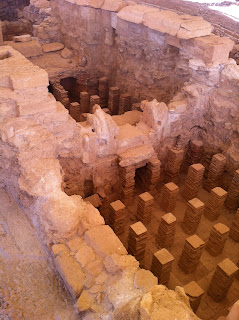Today was a long, hot one! Seven hours in over 100 degree F weather. We were fortunate enough to have
our own personal tour guide through some of the large archaeological sites…
When I was out here three years ago I met one of the nicest individuals ever,
Frank. He is technically retired British military, but archaeology has become
his passion. As a result, he’s started an archaeological society on the RAF
base (where my site is) and assists with all major excavations on the island.
He is fantastic! He very generously volunteered to take Kathy, Paige, Ryan and
I out to the Temple of Apollo, the stadium and the city state of Kourion. It
was quite an extensive visit, full of information, so I will break it up into
at least two posts. Maybe three.
 Our first stop was the temple of Apollo. It was an extensive
temple that was originally built for the cult that worshiped ‘trees’… Tree
huggers, as Frank referred to them. Over time it was converted to the temple of
Apollo (as the religion was converted). There were three consecutive temples
built through the lifespan of the site. Frank took us through as though we were
visiting the temple ourselves.
Our first stop was the temple of Apollo. It was an extensive
temple that was originally built for the cult that worshiped ‘trees’… Tree
huggers, as Frank referred to them. Over time it was converted to the temple of
Apollo (as the religion was converted). There were three consecutive temples
built through the lifespan of the site. Frank took us through as though we were
visiting the temple ourselves.
Here is one of the lodging areas. People would walk to the
temple (all temples are spaced a days walk away from each other), stay in one
of these apartments with the animals and the slaves on the bottom and their
sleeping quarters would have been located above.
You then have the plaza area where vendors would sell idols that one could leave at the alter as you approached the temple itself. The standing pillars are a partial reconstruction of the most recent of the three alters/temples. All temples were built next to each other as opposed to on top… just in case building on top of an old temple would make the gods angry J
 The reconstruction has a few of the original stones in it, but is largely based on designs that were popular at the time in other locations...
The reconstruction has a few of the original stones in it, but is largely based on designs that were popular at the time in other locations...Finally, at the far end of the temple you have the baths. The Romans loved their baths. They would douse themselves in olive oil and then scrape it off. In the picture you see the large stacks of thin brick. These would have been underneath the flooring and the water/baths would have been directly above. The would keep large fires burning that would heat the air underneath the baths, keep it circulating and warm all of the water.
I should note that there are no water sources near the site, and the water is all piped in from the mountains via small clay pipes built up on wooden supports. Would have been amazing to see those structures crossing the valleys!
Pretty remarkable site to walk around and experience.




This is amazing. I hope to meet Frank when we come down.
ReplyDelete